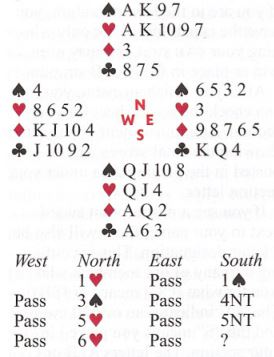Dear Jerry, I have heard that an eight-card trump fit that is divided 4-4 is often superior to a 5-3 fit. This makes no sense to me. Can you help? Ruth-Ann
Hi R-A, I have a lesson hand that I use in my seminars that explains this point.

Auction: South, intending to play some number of hearts, marks time with a 1

response. After the jump raise, things change! Should South pass or bid 6

? Key points: Extra trump tricks usually come by ruffing in the short hand, i.e., the hand with the least number of trumps. Ruffing in the long hand prevents losers, but rarely creates extra winners.
Consider 6

versus 6

. With spades as trump, there are 13 tricks by ruffing two diamonds in dummy. With hearts as trump, there are only 11 winners — the only ruffs available are in the long hand. Fact: Faced with a choice between a 5-3 or 4-4 trump fit, the 4-4 fit is usually superior. Reason: With equally divided trumps, either hand may become the short hand to create extra winners. With unevenly divided trumps, the short hand is preordained.
Dear Jerry, I have been taught that in the 2/1 sequence 1

-2

, the 2

response must promise five hearts.
So I would like to know:
1. Why does the 2

response have to guarantee five cards?
2. What if responder holds a 3=4=3=3 hand with four hearts and game-forcing values? Does he have to respond 2

or 2

with three cards? Peter Y.
Hi Peter, The quest to identify an eight-card or longer major-suit fit is the back-bone of current bidding theory. In addition, a 4-4 fit usually plays at least as well and often better than a 5-3 fit. If your partner opens 1

and you hold:

K85

AQ92

K52

J87, your side has game values and at least eight spades. There could be a superior 4-4 heart fit, and if opener holds a two-suited maximum, there could be a slam. Consider your options. If you play limit raises, any immediate spade raise either understates your values or overstates your support. A forcing Standard American 2NT, if avail-able, would allow you to show your balanced 13-15 points, and when followed by raising spades, announce a fit.
Most partnerships, however, use 2NT as an artificial game-forcing raise (Jacoby 2NT) guaranteeing four or more trumps.
A Jerry-ism:
The best available bid is often the least bad option!
Faced with this dilemma your “least bad” bid is 2

leaving all levels and denominations still in play. If hearts are to become trump, opener needs to hold at least four. A 2

response makes it easy for opener to bid hearts if he has them. If he doesn’t have four or more hearts, what does it matter if you hold four? This all comes from the fact that a 2

response to a 1

opening bid guarantees a five-card or longer holding and invites opener to support with three or more cards. This is actually correct in Standard American or playing 2/1 as forcing to game. I hope this helps.
 Auction: South, intending to play some number of hearts, marks time with a 1
Auction: South, intending to play some number of hearts, marks time with a 1 or 2
or 2 leaving all levels and denominations still in play. If hearts are to become trump, opener needs to hold at least four. A 2
leaving all levels and denominations still in play. If hearts are to become trump, opener needs to hold at least four. A 2 response makes it easy for opener to bid hearts if he has them. If he doesn’t have four or more hearts, what does it matter if you hold four? This all comes from the fact that a 2
response makes it easy for opener to bid hearts if he has them. If he doesn’t have four or more hearts, what does it matter if you hold four? This all comes from the fact that a 2



























